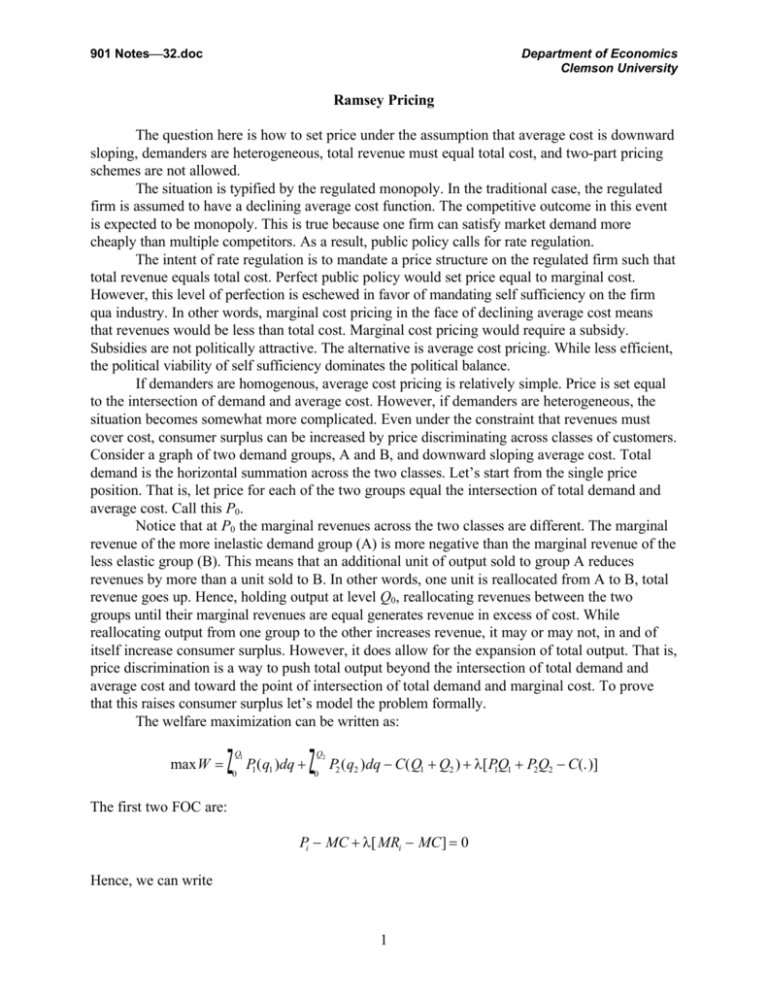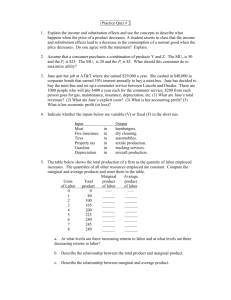1 Ramsey Pricing The question here is how to set price under the
advertisement

901 Notes 32.doc Department of Economics Clemson University Ramsey Pricing The question here is how to set price under the assumption that average cost is downward sloping, demanders are heterogeneous, total revenue must equal total cost, and two-part pricing schemes are not allowed. The situation is typified by the regulated monopoly. In the traditional case, the regulated firm is assumed to have a declining average cost function. The competitive outcome in this event is expected to be monopoly. This is true because one firm can satisfy market demand more cheaply than multiple competitors. As a result, public policy calls for rate regulation. The intent of rate regulation is to mandate a price structure on the regulated firm such that total revenue equals total cost. Perfect public policy would set price equal to marginal cost. However, this level of perfection is eschewed in favor of mandating self sufficiency on the firm qua industry. In other words, marginal cost pricing in the face of declining average cost means that revenues would be less than total cost. Marginal cost pricing would require a subsidy. Subsidies are not politically attractive. The alternative is average cost pricing. While less efficient, the political viability of self sufficiency dominates the political balance. If demanders are homogenous, average cost pricing is relatively simple. Price is set equal to the intersection of demand and average cost. However, if demanders are heterogeneous, the situation becomes somewhat more complicated. Even under the constraint that revenues must cover cost, consumer surplus can be increased by price discriminating across classes of customers. Consider a graph of two demand groups, A and B, and downward sloping average cost. Total demand is the horizontal summation across the two classes. Let’s start from the single price position. That is, let price for each of the two groups equal the intersection of total demand and average cost. Call this P0. Notice that at P0 the marginal revenues across the two classes are different. The marginal revenue of the more inelastic demand group (A) is more negative than the marginal revenue of the less elastic group (B). This means that an additional unit of output sold to group A reduces revenues by more than a unit sold to B. In other words, one unit is reallocated from A to B, total revenue goes up. Hence, holding output at level Q0, reallocating revenues between the two groups until their marginal revenues are equal generates revenue in excess of cost. While reallocating output from one group to the other increases revenue, it may or may not, in and of itself increase consumer surplus. However, it does allow for the expansion of total output. That is, price discrimination is a way to push total output beyond the intersection of total demand and average cost and toward the point of intersection of total demand and marginal cost. To prove that this raises consumer surplus let’s model the problem formally. The welfare maximization can be written as: max W = z Q1 0 P1 ( q1 )dq + z Q2 0 P2 ( q2 )dq − C( Q1 + Q2 ) + λ[ PQ 1 1 + P2Q2 − C(.)] The first two FOC are: Pi − MC + λ[ MRi − MC ] = 0 Hence, we can write 1 901 Notes 32.doc Department of Economics Clemson University P1 − MC P − MC = 2 MR1 − MC MR2 − MC This expression has an intuitive interpretation; the two sides of the expression are like marginal cost, marginal benefit ratios. The welfare maximum is achieved where the marginal cost to one group divided by its marginal benefit is equal to the marginal cost, marginal benefit ratio of the other group. Price minus marginal cost is marginal welfare cost. In other words, for maximum welfare we want price to equal marginal cost. As price is pushed away from marginal cost welfare declines. On the other hand, the constraint in this problem is to raise money to support the project. Marginal revenue minus marginal cost is the money raising benefit of moving price away from marginal cost. Like most economic problems, this one says equal cost-benefit ratios across alternatives. Another way to write this expression is: P1 − MC 1 / ε1 P1 = P2 − MC 1 / ε 2 P2 P1 − MC is P1 the proportion of price that is above marginal cost. The expression says that the efficient tax rates in this case are inversely proportional to the demand elasticities. We can call the left-hand side of this equation the ratio of the tax rates. In this sense 2








